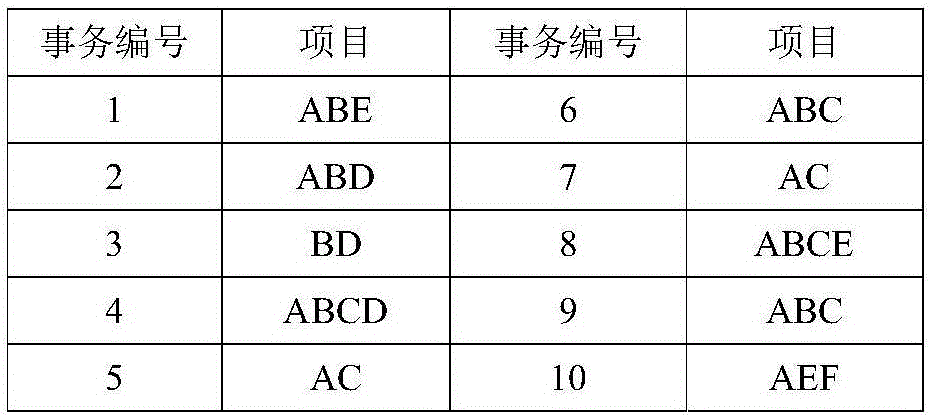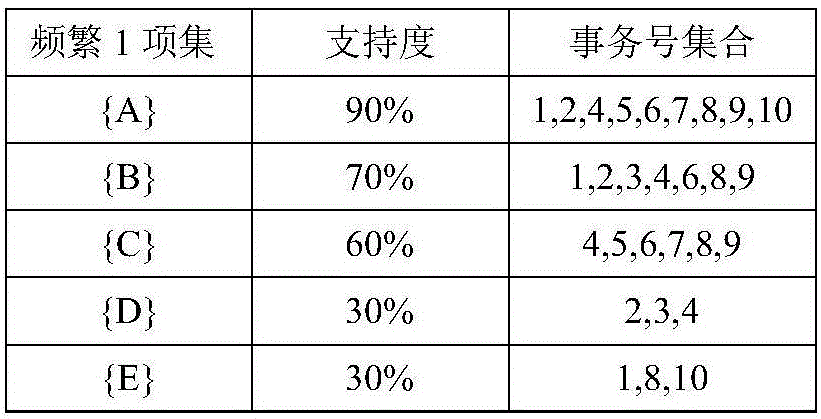Local scan association rule computer data analysis method based on pre-judging screening
A data analysis, computer technology, applied in computing, data mining, electrical digital data processing, etc.
- Summary
- Abstract
- Description
- Claims
- Application Information
AI Technical Summary
Problems solved by technology
Method used
Image
Examples
Embodiment 1
[0062] Such as Figure 10 Shown, the present invention comprises the steps:
[0063] Step 1, scan the transaction database D to get the set L of frequent k-1 itemsets k-1 ;
[0064] Step 2, the set L of frequent k-1 itemsets k-1 Connect with itself to generate a set of candidate k-itemsets, and the set of candidate frequent k-itemsets is denoted as C K ;
[0065] Step 3, using the Apriori property (all non-empty subsets of any frequent itemset must also be frequent, if a candidate non-empty subset is not frequent, then the candidate must not be frequent) to set C K pruning;
[0066] Step 4, calculate the set C K Pre-judgment support of members in the group, and pre-judgment screening;
[0067] Step 5, perform partial scan judgment on the transactional database D;
[0068] Step 6: Repeat steps 2 to 5 above until no larger frequent itemsets can be found;
[0069] Step 7, the final frequent item set set is recorded as F, then the association rule R={X->Y, X, Y is the fre...
Embodiment 2
[0088] through the pair such as Figure 9 The supermarket sales data set shown (the data set contains 10,000 sales records, that is, 10,000 things, 112 kinds of commodities, that is, 112 items) uses the MAWP algorithm to analyze the association rules, and the performance of the MAWP algorithm is verified. Minimum support min_support=0.05.
[0089] In this example, the frequent itemsets obtained by running the MAWP algorithm and the AWP algorithm and the Apriori algorithm are exactly the same, but the Apriori algorithm needs to scan the data set 967 times, while the MAWP algorithm and the AWP algorithm only need to scan the data set 682 times, compared with the Apriori algorithm. Reduced by 29.47%; the number of transactions scanned by the Apriori algorithm is 9.67×10 6 , the number of transactions scanned by the AWP algorithm is 6.82×10 6 , the number of transactions scanned by the MAWP algorithm is 4.6992×10 5 Compared with Apriori algorithm and AWP algorithm, MAWP reduces...
PUM
 Login to View More
Login to View More Abstract
Description
Claims
Application Information
 Login to View More
Login to View More - R&D
- Intellectual Property
- Life Sciences
- Materials
- Tech Scout
- Unparalleled Data Quality
- Higher Quality Content
- 60% Fewer Hallucinations
Browse by: Latest US Patents, China's latest patents, Technical Efficacy Thesaurus, Application Domain, Technology Topic, Popular Technical Reports.
© 2025 PatSnap. All rights reserved.Legal|Privacy policy|Modern Slavery Act Transparency Statement|Sitemap|About US| Contact US: help@patsnap.com



